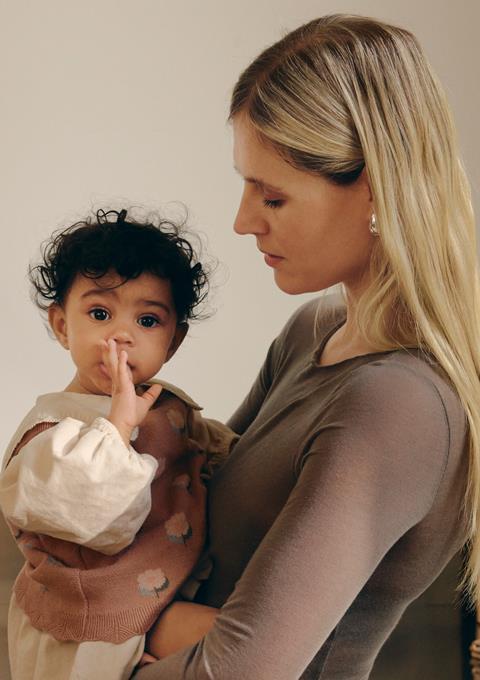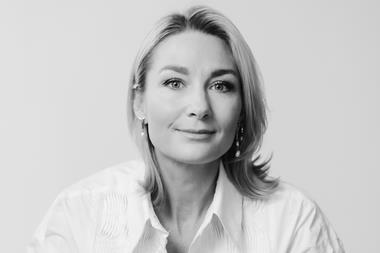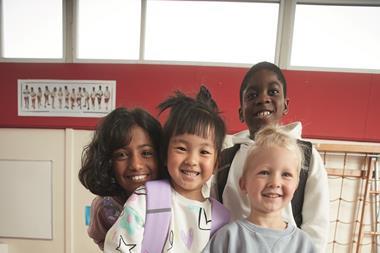As spin-off premium kidswear brands are on the rise, Retail Week explores the baby boom of kids’ clothing, the pros and cons of expanding into the category, and why there has been such a surge in demand.
It would be fair to call 2024 a relatively tough year for many of the fashion retailers who have battled with rising costs, cautious consumers and higher expectations from quality and price points than ever before. But there’s one element of the fashion market that has continued to thrive – childrenswear.
While unsurprisingly, Next, Marks & Spencer and Primark continue to come up trumps in the kids fashion department, there has been an increase in the demand for more premium options for the next generation of fashionistas.
AllSaints, Superdry, H&M and Adanola have all been among those launching premium spin-off brands for little ones this year, offering miniature versions of iconic products, allowing shoppers to lean into the trend of matching mum and daughter and dad and son outfits, or as it’s more commonly known, ‘mini me’ dressing.
With this in mind, Retail Week looks at who is doing what in the childrenswear space, if launching a premium spin-off brand is really worthwhile, and why no matter what, consumers will always spend the big bucks on kids fashion.
A year of new entries
While Next, M&S, Zara, Primark and the supermarket favourites Tesco, Sainsbury’s and Asda have been championing childrenswear for quite some time, it’s fair to say the competition is ramping up.
2024 saw the introduction of childrenswear categories at fashion and athleisure favourites including AllSaints’ launch of SmallSaints, H&M Adorables, a new collection by Superdry in partnership with Next and most recently, Adanola’s launch of ‘mini icons’.
So while the collections may have some of the cutest names in retail, are consumers really opting for elevated childrens’ fashion?

Enterprise ecommerce platform Scayle, owned by German fashion etailer About You, UK country manager Craig Smith has called the launch of a premium childrenswear brand a “smart avenue” for retailers and brands looking to tap into a new consumer demographic.
“H&M has taken this opportunity – by housing a premium kidswear collection in Selfridges, one of the UK’s most iconic luxury retailers. They can capitalise on the spending power of a new customer base and convert shoppers to its pre-existing offering,” he said. “It’ll be interesting to see if other highstreet retailers follow suit.”
That’s not to say that the launch doesn’t come without it’s challenges. Retail Week has learned that another fashion retailer, which specialises in womenswear and accessories, is eyeing a venture into the childrenswear market but that unspecified challenges have slowed down the process.
Concerns in relation to whether it will be worthwhile were also echoed by retail analyst and consultant Maureen Hinton who said: “The question remains if you can get the volume and the margin that you need as a retailer because the cost of making childrenswear is relative to making adultwear, it is just as high and is not any cheaper. You’ve also got so many different sizes to consider.”
Hinton adds that while childrenswear is undeniably a way to gain complimentary sales, how devoted consumers are to the collections from a repeat-purchase perspective remains to be seen. But will customers shop to the extent of giving their children the wardrobes of Dreams? Only time will tell.
Fashion’s baby boom
Having been most recently valued at $200bn (£157.6bn), according to GlobalData’s analysis, the global childrenswear market is forecast to grow at a compound annual growth rate of more than 2% to the year of 2028.
And despite ongoing concerns over the viability of venturing into childrenswear, a huge driver of childrenswear demand is of course the ongoing growth of children and frequent need for replacements, something GlobalData points out supports the growth of the market even during “tough economic times”.
But this may only come into play with the lower end of the market that is affordable and lower cost. Within the elevated kidswear boom, it’s social media that has really changed the game. The rise of ‘mini me’ dressing and ‘mumfluencing’ among millennials who are placing more importance than ever on children looking just as stylish, or arguably more so, than themselves, has triggered skyrocketing demand.
This is something AllSaints really capitalised on, with chief operating officer Catherine Jobling telling Retail Week: “Some parents are now in their 30s and there’s a gap for the kinds of products they would want to see their kids in within the market, so it’s a real white space.”

Going one step further and a real boost for the future of the childrenswear fashion space is the demand for high-quality – something parents are becoming less inclined to compromise on, as a focus on sustainable materials, quality and durability soars to the top of the priority list for many.
Smith said: “Childrenswear has proven particularly resilient since the pandemic, and there’s now a huge opportunity in this space – both for traditionally affordable brands to expand into luxury through childrenswear, and for legacy luxury brands like Gucci and Burberry to expand their childrenswear offerings and capitalise on this trend.
“It points to a potential shift away from super-fast fashion brands like Shein and Temu, with many buyers now placing quality and durability above low cost, at least when shopping for their children.”
However, with birth rates plummeting and resale of clothes via the likes of Vinted, Depop and eBay on the rise, it remains to be seen just how far the potential of this market and newsness of childrens’ clothing can go.


























No comments yet